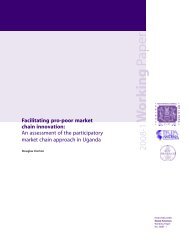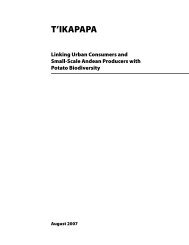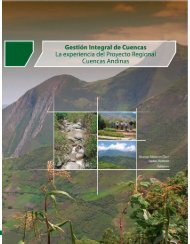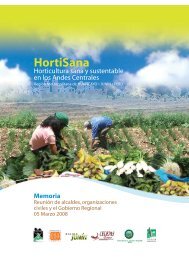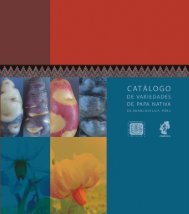Dirty secret treasures in NairobiNairobi has passed through many changes since itsfounding a little more than a century ago. Today it isstill a cosmopolitan city known variously as the “GreenCity in the Sun”, the “Safari Capital <strong>of</strong> the World” or the“Place <strong>of</strong> Cold Waters”, although many parts <strong>of</strong> it haveincreasingly become buried under mounds and heaps<strong>of</strong> garbage and a lot <strong>of</strong> the “cold waters” arecontaminated by sewage. About 40% <strong>of</strong> the more than1740 metric tonnes <strong>of</strong> solid waste generated every dayby its approximately 3 million residents gets collectedand disposed <strong>of</strong>. The rest continues to mount up in openspaces, along the roads, the railroad, the river, formingpiles everywhere in most <strong>of</strong> the residential, industrialand commercial neighborhoods, even in the businessdistrict. Like other cities in developing countries, themunicipal infrastructure has not been able to keep pacewith the rapidly growing population. By the mid-1980s,private waste collectors serviced middle and highincome residential neighborhoods, but lower incomeresidents had to find other solutions to the sanitationproblem. About 50% <strong>of</strong> Nairobi residents live below thepoverty line and are concentrated in peri-urban slumareas characterized by limited amenities and unhygienicliving conditions. By the early 1990s there were a fewsmall-scale community-based composting groups, whoutilize a small amount <strong>of</strong> the accumulation <strong>of</strong> manurefrom the many animals being raised for the local foodmarket.<strong>Urban</strong> Harvest conducted a study in partnership with<strong>International</strong> Livestock Research Institute (ILRI), WorldAgr<strong>of</strong>orestry Center (WAC), both <strong>of</strong> which are centers<strong>of</strong> the Consultative Groups on <strong>International</strong> AgriculturalResearch (CGIAR), Kenya Agricultural Research Institute(KARI) and Kenya Green Towns Partnership Association(KGTPA), which is an NGO. The study illustrated genderinvolvement in management <strong>of</strong> municipal organic solidwaste (MOSW) for urban and peri-urban agriculture aswell as the different aspects <strong>of</strong> waste management aslivelihood strategies. The data was compiled from asurvey conducted in 2003-2004 on management <strong>of</strong>organic waste and livestock manure for enhancingagricultural productivity in urban and peri-urbanNairobi. The objectives <strong>of</strong> the study were to make aninventory <strong>of</strong> community based organizations involvedin organic waste management for urban and peri-urbanagriculture (UPA), document the existing compostinggroups in Nairobi, analyze composting managementtechniques, model rural-urban nutrient movements andlink stakeholders in UPA.In January 2005 the final stakeholder workshop was heldto discuss the results <strong>of</strong> the study <strong>of</strong> waste recycling inNairobi, with a special focus on the use <strong>of</strong> manure andorganic residues in agriculture. Attending the workshopwere representatives <strong>of</strong> the implementation team listedabove plus staff from the Nairobi City CouncilDepartments, national government and civil societyorganizations who are involved in and concerned withthe management <strong>of</strong> urban wastes. It was also a way <strong>of</strong>familiarizing them with the specific objectives <strong>of</strong> theoriginal project, making them aware <strong>of</strong> thecharacterization <strong>of</strong> ecological exchanges <strong>of</strong> nutrientsamong different sectors and geographical areas <strong>of</strong> thecity and the value chain involved in economic27
28exchanges <strong>of</strong> different kinds <strong>of</strong> wastes between rural andurban areas.Waste is a relative term. Although it refers to somethingthat is useless or worthless, it must be borne in mind thatwaste—like beauty—is in the eye <strong>of</strong> the beholder. <strong>Urban</strong>agriculture plays a significant role in urban environmentalmanagement through waste recycling. There are a lot <strong>of</strong>nutrients in urban organic waste (carbon, nitrogen,phosphorus and potassium). Only one percent <strong>of</strong> organicwaste in Nairobi is used for production <strong>of</strong> compost foruse as a bio-fertilizer, another use is for animal feed,particularly kiosk and restaurant waste for pigs and goats.Inorganic waste (plastics) can be used to make usefulproducts: hats, bags and baskets, ro<strong>of</strong> tiles, fence posts,cages for small farm animals and containers for compost.Cardboard and packaging can be used for buildingmaterials, oily milk containers and some cardboard areused for fuel. Clearly there is an opportunity here toincrease income from both waste and more efficientfarming and to contribute to a cleaner, healthier localcommunity. This type <strong>of</strong> recycling helps solve anenvironmental problem while providing income for theurban poor.<strong>Urban</strong> agriculture also plays a significant role in wastewaterrecycling through irrigation. This opportunity for urbanwaste recycling has not been exploited due to lack <strong>of</strong> spacefor waste recycling activities and absence <strong>of</strong> appropriatepolicy on waste management. <strong>Urban</strong> agriculture also helpsput idle urban land into productive use.Problems identified which inhibit successful recyclinginclude: (1) insecure access to land for composting, poorgroup management leading to internal conflicts, whichprevents taking advantages <strong>of</strong> economies <strong>of</strong> scale inwaste handling and processing; (2) declining groupmembership due to the still underdeveloped compostmarket and the hard work involved in compostproduction, especially considering the onlytransportation used is the wheelbarrow and (3) atendency to resort to traditional compostingtechniques having rejected newly introducedtechniques.Research on the chemical composition <strong>of</strong> differentcompost sources being used in Nairobi indicated thatthe quality is generally high and there is potential forgreatly increasing the quantity produced. Studies <strong>of</strong>residue markets described a complex network <strong>of</strong>nutrient flows linking rural and urban areas: someurban livestock producers export their surplus fodderto rural areas, while others use compost they haveproduced for their own crops. There is also cocomposting<strong>of</strong> local materials (mixing <strong>of</strong> manure andvegetative residues), which is comparable to what isdone in rural areas. Half <strong>of</strong> the livestock producers usetheir manure for crop production and some sell or giveit away. However, a most disturbing finding was thatup to 80% <strong>of</strong> manure is dumped or burned in publicareas. This represents a large economic loss toagricultural producers and a high potentialenvironmental and health cost to the city.Intriguingly, while urban manure is mostly considereda nuisance, rural manure from Maasai cattle herders ispart <strong>of</strong> a flourishing trade, some sold to peri-urbanvegetable producers and urban nurseries, but mostlytraded on through the city to rural producers in otherparts <strong>of</strong> the region as far as 300 km away. Compostingis not a common practice, which probably accountsfor the high price <strong>of</strong> compost compared to manure.The study found that compost producers, who usuallyadvertise and trade their product on site, are unfamiliarwith marketing strategy and opportunities whilepotential customers are unaware <strong>of</strong> compost sourcesand its high quality. Better marketing skills anddiffusion <strong>of</strong> knowledge could transform this “hiddenresource” into a major source <strong>of</strong> income, earnings andsavings for compost makers and growers alike.
- Page 1 and 2: Impacts of urbanagricultureHighligh
- Page 3 and 4: 2Impacts of urban agricultureHighli
- Page 6 and 7: IntroductionThe CGIAR 1 System-wide
- Page 8: 7RESEARCH FRAMEWORKThe Urban Harves
- Page 11 and 12: Flower power in the Philippines:Str
- Page 13 and 14: 12At the policy level, CIP-UPWARD-U
- Page 16 and 17: tours offered all over the country.
- Page 18 and 19: Identifying best bet marketingoppor
- Page 20 and 21: What should I feed my child?Percept
- Page 22 and 23: Introduction to Urban ecosystems he
- Page 24 and 25: Pesticide-related health hazards ar
- Page 26 and 27: test whether contamination was redu
- Page 30 and 31: The chaotic state of solid waste ma
- Page 32 and 33: themselves, both recently harvested
- Page 34 and 35: Introduction to stakeholderand poli
- Page 36 and 37: invited to attend this public prese
- Page 38 and 39: An urban agricultural model in the
- Page 40 and 41: Security, Agriculture and Livestock
- Page 42 and 43: KARI in July 2004. One of the recom
- Page 44 and 45: NetworkingLocal and global networki
- Page 46 and 47: Networking and capacity building ac
- Page 48 and 49: 47Final Stakeholder Workshop on Iss
- Page 50 and 51: LATIN AMERICA49Activities Location
- Page 52 and 53: 51Foro Electoral Políticas y Compr
- Page 54 and 55: Dubbling M., G. Prain, M. Warnaars,
- Page 56 and 57: Peters, D., Ngai, DO Duc 2004 Agro
- Page 58 and 59: University of the Philippines,Dilim
- Page 60 and 61: Investment partners59Bundensministe
- Page 62 and 63: STUDENTS AND INTERNS61LimaTomás Al
- Page 64 and 65: Abbreviations and acronymsCEPISCESA
- Page 66: Urban Harvest is the CGIAR system w






